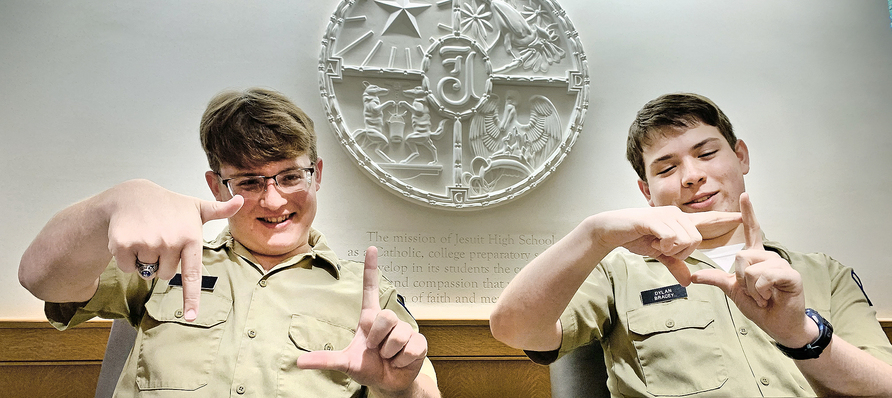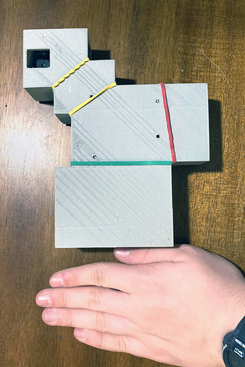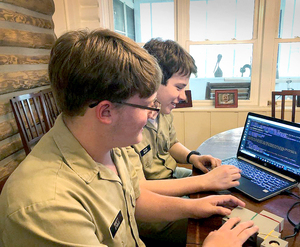
A platform that encourages healthy conversation, spiritual support, growth and fellowship

NOLACatholic Parenting Podcast
A natural progression of our weekly column in the Clarion Herald and blog

The best in Catholic news and inspiration - wherever you are!
Jesuit students’ prototype baby car alarm can save lives
-

By Peter Finney Jr.
Clarion Herald
As another summer approaches, the statistics are chilling.In 2019, 32 children in the U.S. died of heatstroke because they were accidentally left behind in a car by a distracted parent. In nearly half of those tragedies, according to the National Highway Traffic Safety Administration, the child was supposed to have been dropped off at daycare or preschool.
But the parent forgot the baby was in the car.
For the last two years, finding a solution to such a real-world problem has been the passion of two Jesuit High School students – graduating senior Brett Steele and junior Dylan Bracey.
Their collaboration, which started when they were colleagues on Jesuit’s robotics team, led to the creation of a baby car alarm, able to be mounted in any automobile, that detects the movement of a human or a pet inside a car and triggers an alarm and sends a warning message to a Smartphone if the car reaches a dangerous temperature.
 Won the city competition
Won the city competition
Steele’s and Bracey’s alarm was one of four grand prize winners in the Greater New Orleans Science and Engineering Fair and also is in contention, among 1,300 other entries, in the Regeneron International Science and Engineering Fair for its $50,000 grand prize.Steele and Bracey completed their online pitch to the international judges in early May, and they will find out May 20 if they have won. Their invention already has received a provisional patent.
“It’s great to know that we can do something to help change the world for the better,” Bracey said.
Bracey said the impetus for the project came from watching the news with his parents one night about another infant death inside a hot car.
“Every year, they have one of these advisories, ‘Don’t leave your kid in the car because it can get really hot,’” Bracey said. “In five minutes, your kid might be dead.”
Original idea changed
One of the original ideas, from Bracey’s mother, was to develop a rain sensor that would automatically shut car windows in the summer in case of a storm. That would allow the driver to keep the windows down so the car did not reach extreme heat levels.“Then it developed into, ‘Oh, we can actually try to save people’s lives,’” Bracey said.
Instead of the rain sensor, Steele and Bracey dreamed up a device that could be added to any car – mounted near the driver’s visor – that has a camera that points to the back of the car.
“So that it can see everything,” Steele said. “We use that camera to detect whether or not there’s a person in the car or not. It uses thermal imaging.”
 So, if the camera detects movement and if the temperature reaches a certain level, Bracey said, “there are bright LEDs that will flash Morse code at the front of the windshield.”
So, if the camera detects movement and if the temperature reaches a certain level, Bracey said, “there are bright LEDs that will flash Morse code at the front of the windshield.”“Once it goes through all of its detection phases, it goes into an alarm phase,” Steele said. “And that’s when it starts saying, ‘Hey, there’s someone in danger.’”
The students even have figured out how to handle “blind spots” that might not be detected inside the car.
“Our current plan is to have these little infrared, reflective mirrors that can be mounted to the seat itself,” Steele said. “There are already mirrors for parents to see the babies in the rear-facing seats. Those mirrors will reflect the infrared so the camera can see it.”
Hope to use in current cars
Another benefit of the system is that it can be retrofitted to any car. Certain auto manufacturers are working on plans to have detection systems – some that might detect a heartbeat – manufactured into their cars.“That would be a very sensitive sort of sensor, but I’m not exactly how far along it is,” Steele said.
Steele and Bracey said the lobbying group, kidsandcars.org, is advocating for federal legislation that would require car manufacturers to have a baby car alarm system in place on new models.
“We attended an international conference, and they noted they have not yet found a way to have the system retrofitted into older models,” Bracey said. “That’s when we pivoted from using something that would interface with the car to something that is completely stand-alone and modular and can go anywhere.
“There are some companies that are making devices to solve the same problem, but none of them that we know of are able to scan the entire car from one device or do so accurately without it being integrated into the car itself.”
On a very practical level, the students say they can understand why parents might get distracted and forget their child. The level of distraction is immense these days.
“I’ve left my lunch in the car and I’ve left a few school books when I’m rushing to get to school,” Steele said. “I can definitely see how someone might accidentally leave their child.”
The students’ goal over the summer is to make their model smaller.
“It’s about half as long as a car visor and three-fourths as tall,” Steele said. “If we could shrink it down some more, it'd be a lot better for us.”




